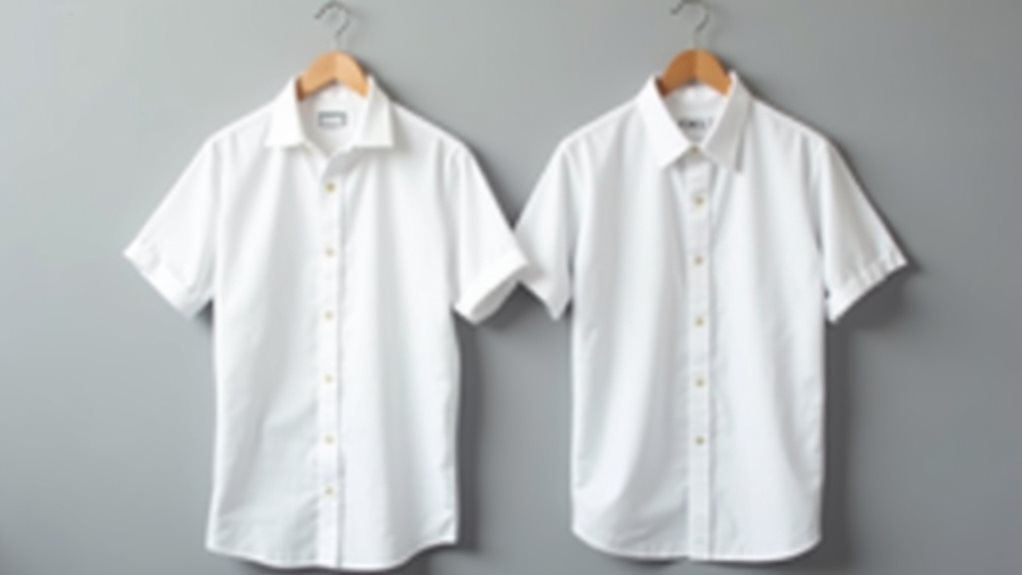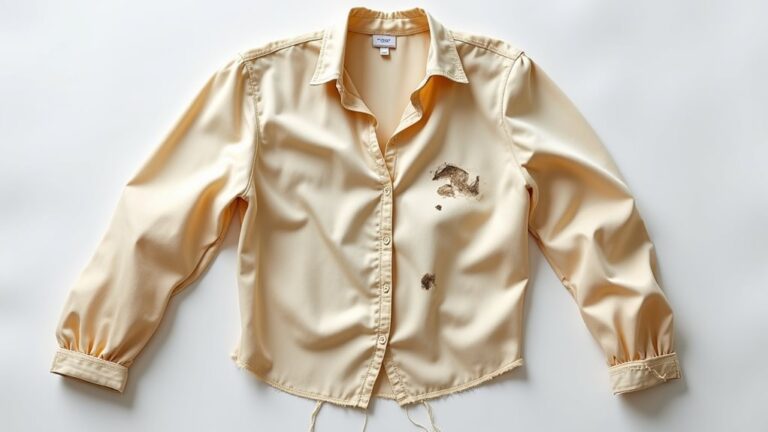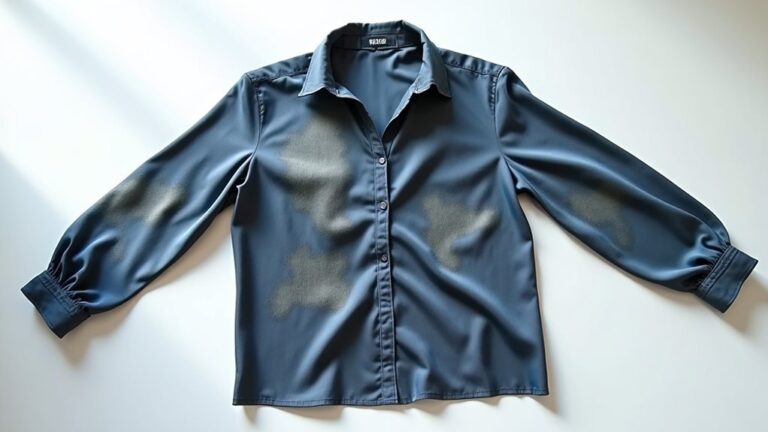Dry cleaning can shrink your clothes, though it’s less likely than traditional washing since it uses chemical solvents instead of water. However, malfunctioning equipment that introduces excess heat or moisture can cause shrinkage, especially in natural fibers like wool, cotton, and linen. I’ve learned the hard way that even “dry clean only” garments aren’t immune to shrinking when machines break down or cleaners use aggressive pressing techniques. Understanding these risks helps you protect your favorite pieces.
Understanding the Science Behind Fabric Shrinkage
When you’ve watched your favorite sweater transform from a perfect fit into something that could dress a small child, you’re witnessing the fascinating yet frustrating science of fabric shrinkage in action.
Watching your favorite sweater shrink into doll-sized clothing reveals the maddening molecular science happening in your washing machine.
Here’s what’s really happening: your clothing fibers are literally contracting when exposed to heat, moisture, and agitation during cleaning.
Natural fibers like cotton and wool are the biggest culprits because they’re more prone to this molecular dance than synthetic materials.
The heat causes fiber polymers to release tension they’ve been holding since manufacturing, while moisture swells the fibers before they contract.
Does dry cleaning shrink clothes less? Absolutely, because there’s minimal moisture in the dry cleaning process.
Professional dry cleaning uses chemical solvents instead of water, making it gentler on delicate fabrics like silk and wool while helping maintain the original size and shape of your garments.
However, you can still prevent shrinkage by following care labels religiously.
How the Dry Cleaning Process Actually Works

Now that you understand why fabrics shrink, let’s explore how dry cleaning works its magic to keep your clothes looking their best.
Unlike your washing machine at home, the dry cleaning process uses a chemical solvent instead of water, which is honestly brilliant when you think about it. Your garments get a gentle spa treatment that preserves their shape and prevents shrinkage.
Here’s what happens during the process:
- Your clothes are placed in specialized machines that control temperature and moisture levels precisely.
- The chemical solvent cleans without the aggressive agitation that causes fiber distortion.
- Professional equipment maintains ideal conditions to protect delicate fabrics.
This method is particularly amazing for natural fibers that would normally shrink in traditional washing methods. The most common solvent used is perchloroethylene, though many cleaners now offer eco-friendly alternatives like hydrocarbon or liquid CO2.
Common Causes of Shrinkage During Dry Cleaning
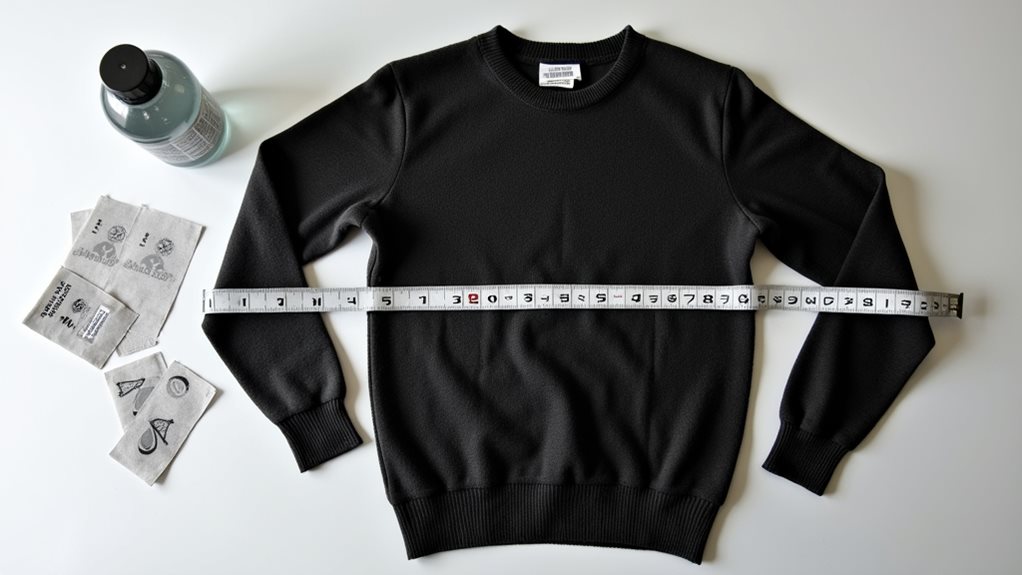
Although dry cleaning is gentler than traditional washing, I’ve learned the hard way that things can still go wrong, and your favorite blazer might come back looking like it belongs to your little cousin 😅.
The biggest culprit is usually malfunctioning dry cleaning machines that introduce excess heat or water into what should be a controlled process. When chillers break down or water separators fail, moisture sneaks into the solvent, and suddenly your delicate fabrics are getting the steamy treatment they were meant to avoid.
Broken chillers and faulty water separators turn your gentle dry cleaning into an accidental steam bath for delicate fabrics.
Natural fibers like wool and cotton are particularly vulnerable to this moisture-heat combo, which causes fabric gaps to tighten and contract.
Poor machine maintenance creates the perfect storm for shrinkage, turning your professional cleaning into an expensive mistake. Additionally, aggressive pressing techniques can cause garments to shrink even when the chemical cleaning process itself goes smoothly.
Which Fabric Types Are Most Vulnerable to Shrinkage
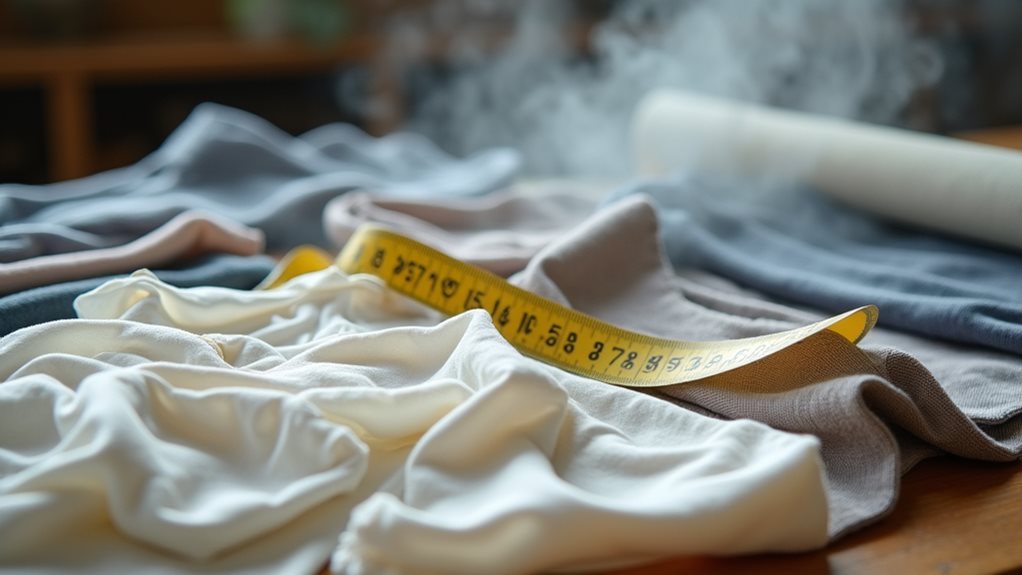
After years of watching my favorite sweaters transform into doll clothes, I’ve discovered that certain fabrics are basically sitting ducks when it comes to shrinkage.
Understanding which ones are most vulnerable can save you from some truly heartbreaking wardrobe disasters.
Here’s what I’ve learned the hard way:
- Natural fibers like cotton, wool, and linen are the biggest culprits because they absorb water and contract when exposed to high temperatures.
- Dry clean only garments often contain delicate fibers that’ll shrink faster than you can say “oops” if they meet water or heat.
- Synthetic fibers like polyester resist shrinkage better, but they’re not bulletproof against excessive heat.
While shrinkage is a major concern, it’s worth noting that many dry cleaners are switching to safer alternatives like wet cleaning and hydrocarbon solvents that can be gentler on both fabrics and your health.
Trust me, knowing your fabric’s personality before you hand it over can prevent those moments when you’re staring at a tiny version of your favorite shirt!
Equipment Malfunctions That Lead to Garment Damage
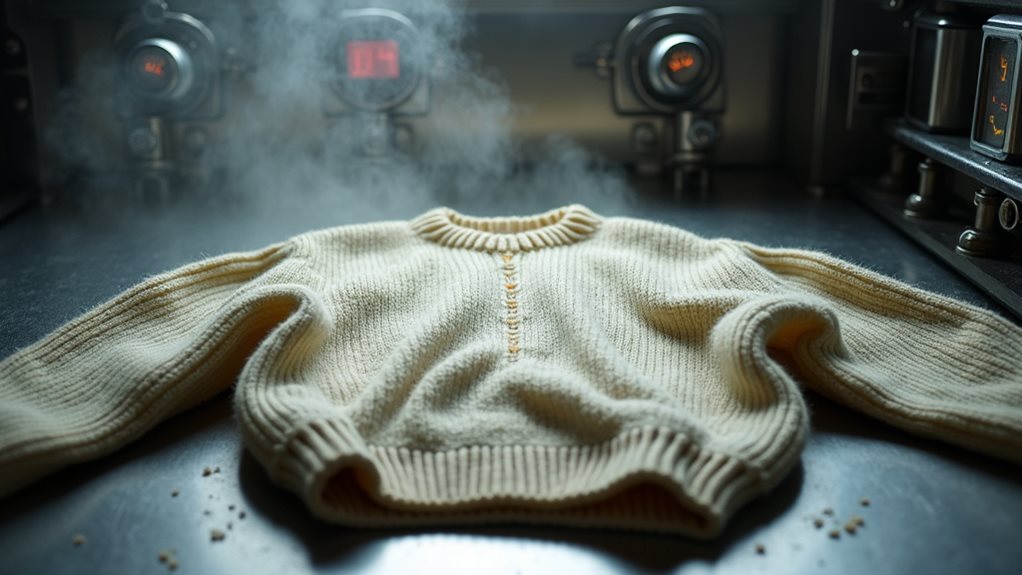
When dry cleaning equipment starts acting up, it’s like having a kitchen timer that randomly decides to add an extra hour to your cooking time—except instead of burnt dinner, you get shrunken clothes that’ll haunt your closet forever.
Equipment malfunctions can seriously compromise garment integrity, and trust me, you don’t want to discover this the hard way with your favorite blazer.
Equipment failures can destroy your most treasured garments in seconds—prevention beats replacing your entire wardrobe any day.
A broken chiller during the cleaning process causes solvents to overheat, literally cooking your fabrics into miniature versions of themselves.
Faulty water separators introduce excess moisture, creating the perfect storm for shrinkage in dry cleaning machines.
When agitation mechanisms go rogue, they’ll shake your garments like a paint mixer, distorting fibers beyond recognition.
The harsh chemical solvents used in dry cleaning can also weaken fabric fibers over time, making them more susceptible to shrinkage when equipment operates outside normal parameters.
Regular maintenance prevents these nightmares—because nobody wants their wardrobe transformed into doll clothes.
Proven Methods to Prevent Shrinkage at the Dry Cleaner

You can absolutely protect your favorite clothes from shrinkage by taking two simple but powerful steps before handing them over to any dry cleaner.
First, invest time in choosing a quality cleaner who specializes in delicate fabrics—I learned this the hard way when my beloved cashmere sweater came back looking like it belonged to my nephew 😅—because experienced professionals understand how different materials react to solvents and heat.
Second, don’t just drop off your garments and hope for the best; instead, communicate your specific concerns about shrinkage directly with the staff, since they can adjust their cleaning methods and temperatures when they know what you’re worried about.
Unlike traditional washing methods that use water and can cause shrinkage in delicate fabrics, dry cleaning uses chemical solvents to safely remove dirt and stains while preserving the fabric’s original structure and appearance.
Choose Quality Cleaners
Since finding the right dry cleaner can feel like searching for a needle in a haystack, I’ve learned through several expensive mistakes that not all cleaning services are created equal 😅.
When you choose quality cleaners, you’re investing in professionals who understand how different fabrics react to various solvents and temperatures, which dramatically reduces your shrinkage risk.
Here’s what I look for when selecting a professional dry cleaner:
- Specialization in delicate fabrics – They should confidently handle silk, wool, and cashmere without hesitation.
- Clear communication about care instructions – Good cleaners ask questions about your garment’s history and specific concerns.
- Well-maintained equipment – Modern, properly serviced machines prevent the moisture and heat issues that cause shrinkage.
Trust me, paying slightly more upfront beats replacing shrunken favorites later.
Quality dry cleaners should also inform you about any pre-existing fabric stress that could increase shrinkage risk, especially in garments that weren’t properly pre-shrunk during manufacturing.
Communicate Garment Needs
After learning the hard way that dry cleaners aren’t mind readers, I’ve discovered that clear communication about your garment’s specific needs can mean the difference between perfectly preserved clothing and expensive disasters 🤦♀️.
Don’t assume your dry cleaners will automatically know that your vintage silk blouse requires extra gentle handling or that your wool sweater has already been through three different cleaning processes.
Take a moment to explain the fabric type, share any shrinkage concerns upfront, and point out specific care label instructions that matter most to you.
Request that they avoid high heat settings during the cleaning process, and don’t hesitate to mention if their equipment maintenance might affect your garment needs—this proactive approach saves heartache later.
Remember that dry cleaning uses chemical solvents instead of water, which helps prevent the shrinkage that typically occurs with traditional washing methods, but communicating your specific concerns ensures your cleaner takes extra precautions.
What to Do When Your Clothes Have Already Shrunk
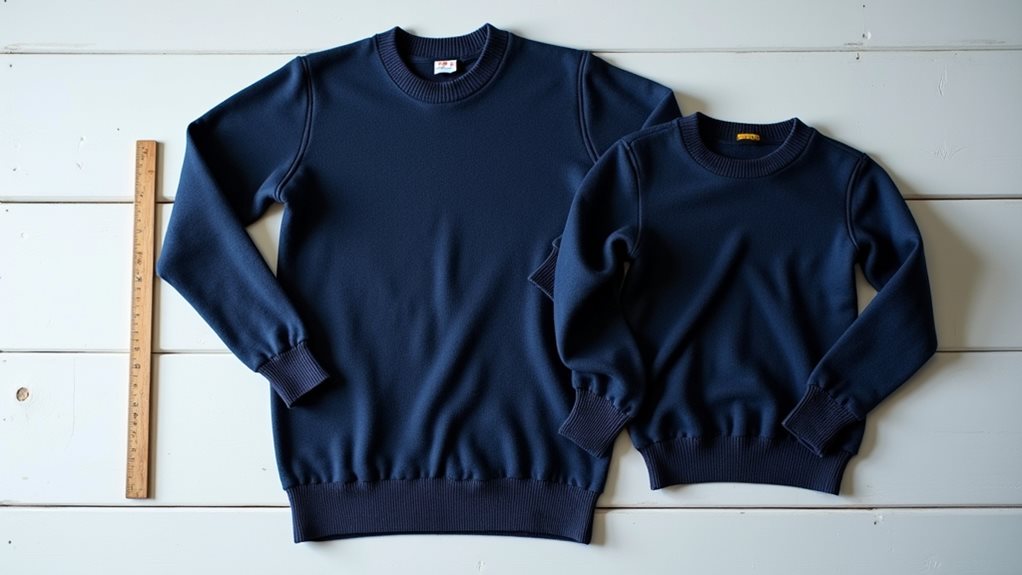
When discovering that your favorite sweater now fits your niece better than you, the sinking feeling in your stomach is all too familiar—but don’t panic just yet, because there are several tried-and-true methods that can help restore your shrunken garments to their former glory.
Here’s what you can do to rescue your clothes:
- Soak and stretch: Mix lukewarm water with fabric conditioner, let your garment soak for 30 minutes, then gently stretch those stubborn fibers back to life.
- Iron and pull technique: For cotton or linen pieces, use a hot iron while carefully pulling the fabric to flatten and lengthen shrunken areas.
- Professional intervention: When all else fails, seek help from experienced dry cleaners who’ve mastered the art of reversing shrink damage.
Sometimes these rescue missions work beautifully, other times you’ll need to accept your accidentally miniaturized wardrobe! 😅
When working with professional dry cleaners, consider choosing those that use eco-friendly solvents instead of traditional chemical processes, as these alternatives can be gentler on both your clothes and your health.
Choosing a Professional Dry Cleaner You Can Trust

When you’re hunting for a trustworthy dry cleaner, you’ll want to dig into their experience with fabrics like yours, because I learned the hard way that not all cleaners understand the delicate dance between solvents and silk 😅.
Ask pointed questions about their machine maintenance schedules, since outdated or poorly serviced equipment can turn your favorite blazer into a child-sized nightmare faster than you can say “professional cleaning.”
The best cleaners won’t hesitate to walk you through their processes, share their years of experience with specific garment types, and explain how they keep their equipment running efficiently to protect your investment.
Look for cleaners who specialize in handling delicate fabrics like wool and cashmere, as these materials require expert knowledge to prevent damage during the cleaning process.
Research Cleaner Experience
Since I learned the hard way that not all dry cleaners are created equal—thanks to a beloved cashmere sweater that returned looking like it belonged to my nephew—I can’t stress enough how crucial it’s to research your cleaner’s experience before trusting them with your wardrobe.
Professional cleaners with extensive experience understand how different fabrics react to various dry cleaning solvents and can adjust their process of dry cleaning accordingly to prevent shrinkage.
When evaluating potential cleaners, focus on these key indicators:
- Years in business and fabric expertise – Look for cleaners who’ve handled diverse materials
- Equipment maintenance records – Well-maintained machines prevent processing mishaps
- Customer testimonials – Real experiences reveal their track record with delicate items
Don’t hesitate to ask direct questions about their shrinkage prevention methods—experienced professionals welcome these conversations.
Machine Maintenance Standards
Beyond researching a cleaner’s experience, you’ll want to pay close attention to their machine maintenance standards, because even the most skilled technician can’t prevent shrinkage if they’re working with poorly maintained equipment.
I learned this lesson the hard way when my favorite wool sweater came back two sizes smaller from a place that clearly hadn’t serviced their machines in ages 😅.
Quality dry cleaning establishments follow strict maintenance schedules, regularly checking temperatures, moisture levels, and calibrating their equipment to protect your garment from damage.
Don’t hesitate to ask about their maintenance practices—reputable cleaners will gladly discuss how often they service their machines.
Customer reviews often reveal maintenance issues, so read between the lines for mentions of shrinkage problems that could indicate neglected equipment.

